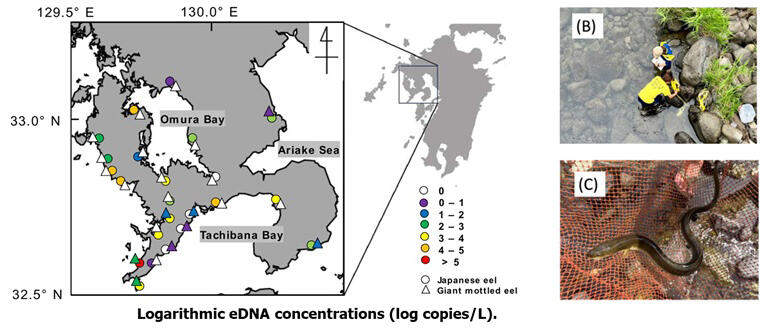A research group led by Associate Professor Mitsuharu Yagi of the Faculty of Fisheries and Graduate Student Yurika Ono of the Graduate School of Fisheries and Environmental Sciences (at the time of the research) at Nagasaki University has announced that they analyzed environmental DNA of eels in rivers in Nagasaki Prefecture and found the habitat distribution pattern differences between Japanese eels and giant mottled eels and new habitat rivers for giant mottled eels. The results were published in the international academic journal Zoological Science on May 2.

Provided by Nagasaki University
Both Japanese eels (Anguilla japonica) and giant mottled eels (A. marmorata) are found in Japan, but their exact distributions, particularly of giant mottled eels, are poorly known. In this study, they conducted environmental DNA analysis at 87 sites in 23 rivers in Nagasaki Prefecture to clarify the distribution patterns of Japanese eels and giant mottled eels. As a result, environmental DNA (eDNA) of Japanese eels was detected in 19 rivers (82.6%). Giant mottled eel eDNA was detected in eight rivers (34.8%), including five rivers that were found, for the first time, to be inhabited by giant mottled eels. They also found that the distribution was distinctively different between Japanese eels and giant mottled eels. Japanese eel eDNA was detected at 6 of 9 sites in the north, 13 of 23 sites in rivers running into Omura Bay, and 37 of 55 sites in the south.
On the other hand, eDNA of giant mottled eels was detected at one of nine sites in the north, no sites in rivers running into Omura Bay, and 15 of 55 sites in the south. There was no correlation between eDNA concentrations of the two species at 10 sites in the five rivers where eDNA of both species was detected. These findings suggest that the distribution of the two eel species differs and that Nagasaki Prefecture may be the northern distribution limit of giant mottled eels in the area facing the East China Sea. They are continuing with the survey in a wider area, including the ocean and rivers.
Yagi commented, "The Japanese eel is famous for deliciousness as 'broiled eel' and when cooked in other ways. However, its abundance is declining, and it is now listed as an endangered species. On the other hand, the giant mottled eel is not very tasty, according to what I have heard, and information on its abundance is lacking. Environmental DNA technology involves measuring the amounts of DNA in water samples collected from rivers. Collecting water samples is often considered a simple task, but that is not true. After hard struggles, we found Japanese eels in many rivers and points in western Kyushu, while giant mottled eels were found only in specific areas and points. These results indicate the importance of diverse river environments from the upper reaches to brackish-water regions for Japanese eels and distinctive habitat environments such as specific rivers and pool structures for giant mottled eels. We also revealed that Japanese and giant mottled eels inhabit urban rivers. A variety of creatures live in the rivers around you, and I would be happy if you could look at them and become interested in the environment and the creatures in rivers."
Journal Information
Publication: Zoological Science
Title: Environmental DNA Reveals Geographic Distributions of Two eel Species, Anguilla japonica and A. marmorata, in Western Kyushu, Japan
DOI: 10.2108/zs230103
This article has been translated by JST with permission from The Science News Ltd. (https://sci-news.co.jp/). Unauthorized reproduction of the article and photographs is prohibited.




